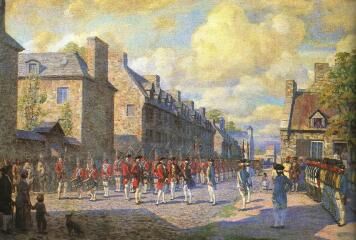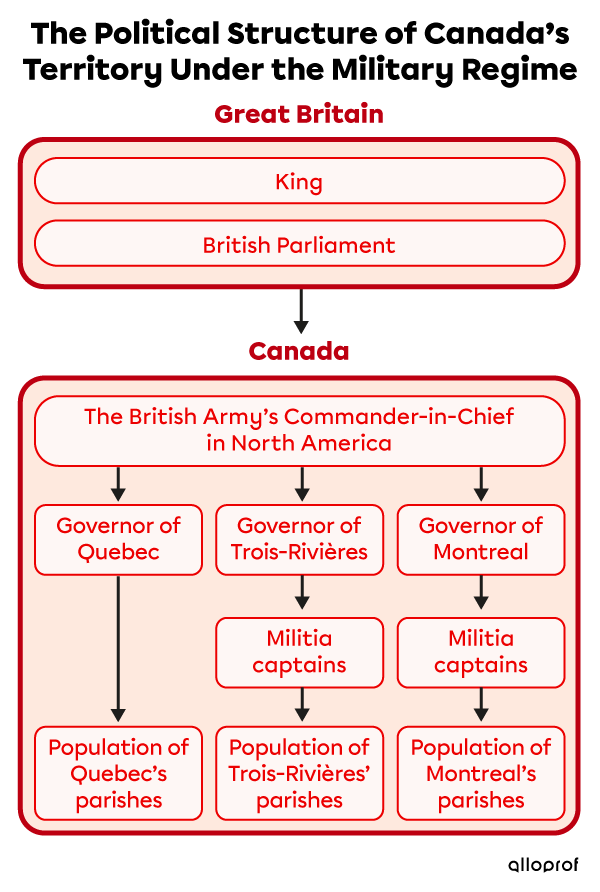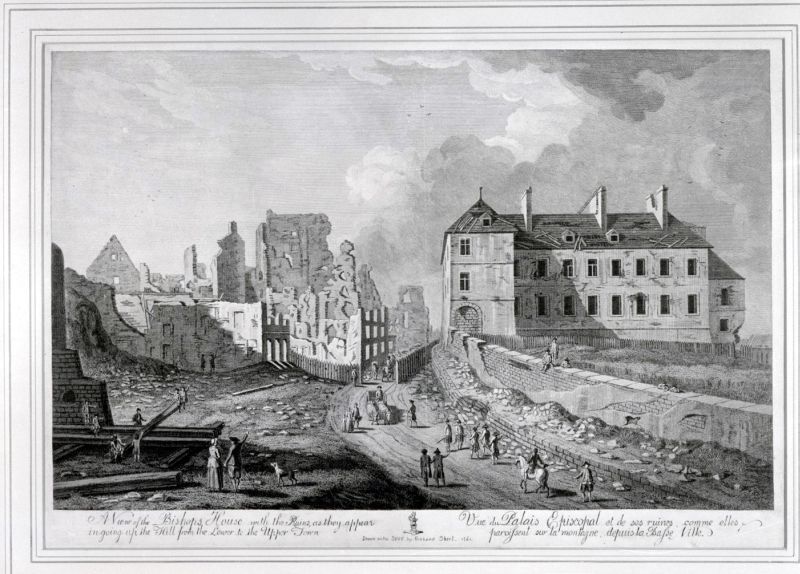The War of the Conquest ended in North America at the end of 1760. But the Seven Years’ War raged on between France and Great Britain until 1763. A provisional government was set up in the colony while awaiting the conclusion of the war and the fate of New France: the military regime (1760–1763). The objective of this military regime was to run the colony and maintain peace and order.
On September 8, 1760, the Governor General of New France, Pierre de Rigaud de Vaudreuil and the Major General of the British army, Jeffrey Amherst, signed the capitulation of Montreal. Vaudreuil had decided to surrender after considering the numerical superiority of the British troops and the exhaustion of his army. However, he negotiated this capitulation by imposing certain conditions to protect the rights of the Canadiens. Montreal’s surrender (capitulation) marked the end of the War of the Conquest.

Surrender of New France in 1760
Source: The Capitulation of Montreal en 1760 [Painting], 1800, Histoires de chez nous, (URL).
With the military regime, the colony fell under the command of British military authorities led by General Jeffrey Amherst. Similar to the French Regime, the districts of Montreal, Quebec City and Trois-Rivières were still overseen by individual governors, but these were now British military officers.

Source: Jeffery Amherst, 1st Baron Amherst [Painting], Gainsborough, T., 1785, National Portrait Gallery, (URL).
An institution is an organization governed by rules and laws that fulfills a specific role in society. This role may be political, social, economic, religious, etc.
Still, few changes were made to the institutions of New France. For example, bureaucrats and militia captains stayed in their positions. The militia captains were employed to the benefit of the British authorities since they provided a link between the vast majority of the population, who were Canadiens (Francophone and Catholic), and the British authorities (Anglophone and Anglican). Therefore, they could convey the orders of the authorities to the population.

Canadiens retained several rights during the military regime. First, they were authorized to keep ownership of their land and property. The majority of French institutions were preserved: French civil law remained applicable, and the Canadiens were allowed to practise the Catholic religion and speak French.
However, they were subject to certain conditions. First, the Canadiens had to surrender their arms to avoid a rebellion. They also had to swear allegiance to the British King, George III, which meant promising loyalty and obedience to him. Finally, French criminal laws were replaced by English criminal laws.
-
Civil laws relate to marriage, divorce, inheritance, land distributions, property and trade.
-
Criminal laws relate to fraud, assault, homicide, theft and high treason.
Before the War of the Conquest, 60 000 people lived in Canada (New France). Even though most of the population decided to remain in the conquered colony, approximately 4 000 Canadiens emigrated during the three years of the military regime. Most were nobles, military officers, large-scale fur traders and administrators.
Yet, few British immigrated to the colony. Only a few hundred British merchants and adventurers arrived, attracted by trade, especially in furs.
-
Emigration is when a person leaves their country (country of departure) to settle in another country (host country) for a fixed or indeterminate period.
-
Immigration is when a person arrives in a foreign country (host country) to settle temporarily or permanently.
The War of the Conquest was very difficult for New France. The Quebec region was particularly devastated following this major conflict. Part of the city of Quebec was destroyed and villages were completely demolished. The habitants suffered from famine because many crops were destroyed. The British authorities were therefore faced with the massive undertaking of rebuilding the colony.

Source: Vue du Palais épiscopal et des ruines, comme elles paraissent sur la montagne, depuis la Basse-Ville, Québec [Etchings], Short, R., vers 1770, BANQ, (URL).
Gainsborough, T. (1785). Jeffery Amherst, 1st Baron Amherst [Painting]. National Portrait Gallery. https://www.npg.org.uk/collections/search/portrait.php?search=ap&npgno=150&eDate=&lDate=
Short, R. (circa 1770). Vue du Palais épiscopal et des ruines, comme elles paraissent sur la montagne, depuis la Basse-Ville, Québec [Etchings]. BANQ. https://numerique.banq.qc.ca/patrimoine/details/52327/3121616
Histoires de chez nous. (1800). Capitulation de Montréal en 1760 [Painting]. https://www.histoiresdecheznous.ca/v1/pm_v2.php?id=record_detail&fl=0&lg=Francais&ex=00000580&rd=138805